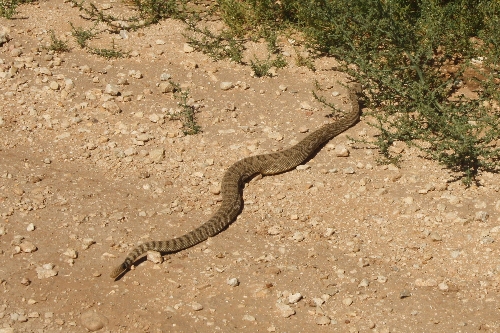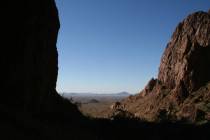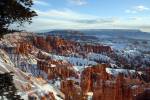Leaving snakes alone benefits both parties
It is that time of year again when resident rattlesnakes start appearing on our local hiking trails. They come out of hibernation to enjoy the 70- to 90-degree temperature range, just as many humans do.
People seem to love talking about rattlesnakes, and from all the snake stories, you'd think rattlesnake encounters were daily occurrences. Yet some people I know have lived here for decades, spent much of that time outdoors and haven't yet seen one.
Snakebites are rarer still, partly because experienced outdoor people have learned how to behave in snake country. Unlike many other wild animals, snakes don't seem to hear you coming and get out of your way; it's up to you to avoid them. Most of the time in the spring, snakes are just hanging out, sunning themselves, and they blend into the background because they aren't moving. So smart veteran hikers never put their hands and feet where they haven't looked. When the weather gets hotter, the snakes will prefer to hang out in the shade of rocks or bushes, but the same rule applies there: Look before stepping.
Rattlesnakes are nocturnal hunters, so they're more active at night, especially when the weather gets hotter. If you're camping, be sure to use a flashlight or headlight when you walk around at night, despite the understandable temptation to enjoy strolling by moonlight alone.
In our area, there are four types of rattlesnakes: the sidewinder, Mojave, speckled and western diamondback. Of these four, the sidewinder is the smallest; adults are just a couple of feet long. But the western diamondback can grow to well over 6 feet, with the speckled and Mojave in between.
Learning to identify them is easiest through photographs via the Internet or by a field guide that shows color photographs such as the "National Audubon Society Field Guide to North American Reptiles & Amphibians."
Most snakebites don't happen to hikers accidentally stepping on serpents; many or perhaps most bites occur when people meddle with snakes. Given the chance, most snakes will eventually retreat to the nearest bush. Only once have I seen a rattlesnake try to strike. Many years ago, after a swim in the Colorado River, my daughter was climbing out on a rocky bank, using her hands to help her up. A rattlesnake happened to be quite near and struck at her, missing her face by inches.
Although people have died of snakebites, most human victims do not. One reason is that some victims don't get a full dose of venom because one of the two fangs fails to penetrate into the flesh. Also about half of bites are dry, with no venom injected at all. It's important to remember these things because if you are unlucky enough to get bitten, knowing your chances of survival are quite high makes it much easier to act rationally in the emergency.
If you do get a bite, it's far better to head immediately for the nearest hospital instead of wasting time with old-fashioned do-it-yourself treatments, such as cutting and sucking the wound. It is a good idea to place a constriction band between the bite and the heart. It shouldn't be as tight as a tourniquet would be; you're trying to slow body fluid circulation, not stop it entirely. An Ace bandage, carried in many first-aid kits in case of sprains, is also an excellent constriction band. If you don't have one, you can quickly improvise something similar from the elastic in clothing. Avoid increasing blood circulation as it makes the venom spread through your body quicker. Walk, don't run, to your vehicle; better yet, if the terrain allows it, have someone go get the vehicle and bring it while you wait quietly.
I have seen a couple dozen rattlesnakes over the years, and last year alone I saw at least four hereabouts, including two western diamondbacks. Once I even saw a rattlesnake taking a swim in Lake Mojave. In every instance, I left them alone, and they returned the favor. Knowing I would be safe if I minded my own business made the difference. What might have been an unpleasant memory of fright in the Mojave Desert always became, instead, a pleasant one of encountering one of its most interesting and well-adapted residents.
Deborah Wall is the author of "Great Hikes, A Cerca Country Guide" and "Base Camp Las Vegas: Hiking the Southwestern States," published by Stephens Press. She can be reached at deborabus@aol.com.




























